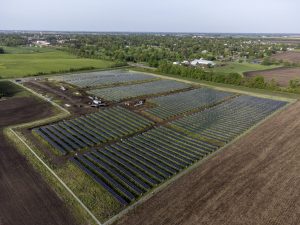(Iowa Capital Dispatch) – Grinnell College has made a “decisive step” forward in the direction of operating without emissions with the completion of a 9,000-panel solar array. College President Anne Harris says one-third of Grinnell College’s campus is now running on renewable energy with the array, the largest private solar installation in the state. As Grinnell College reaches this milestone in its goal of hitting net-zero emissions by 2040, a community-wide solar project could have more than half of the university’s power come from renewable sources.
A third-party developer, Sunlight General Capital LLC, owns the array, and Grinnell College has purchased all of the energy generated from it for the next 20 years, with the possibility of a 10-year extension. The array, which Grinnell College environmental and safety manager Chris Bair said has been in operation for around one month, provides four megawatts of power that flows to almost every building on campus. There are six other smaller solar power stations utilized by the university, he said, which provide energy to buildings off of the main meter like the facilities building and environmental education center.
Each of the panels is double-sided, Bair said, allowing them to gather energy from reflected light like that off snow, and are able to follow the path of the sun from east to west to more efficiently absorb power. Beyond the daily power the solar array provides, a battery connected to the system can store a certain amount of energy for when it’s needed. Bair said this will be most useful when the university’s energy usage is at its highest, like on a hot day in August with all of the air conditioning units on campus running constantly. The battery will help curb the peak, at least a little bit, helping save some money on the energy bill.

The Grinnell College Solar farm, the largest privately owed solar farm in the state of Iowa May 19, 2022.
(Photo by Justin Hayworth/Grinnell College)
Another solar array project spearheaded by Alliant Energy and community partners will provide the university with an additional two megawatts of solar energy, Bair said, ensuring more than half of campus power will come from solar once it is up and running.
Grinnell College is one of many institutions with sustainability plans and practices, Harris said, and all universities should be thinking about solutions like these because they can make a tangible impact on more than just the campus itself, but the community that houses it.





